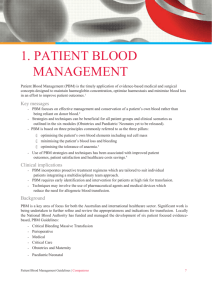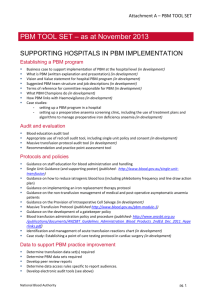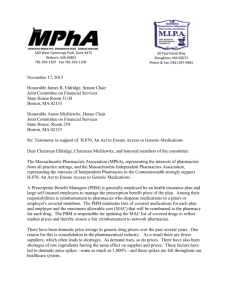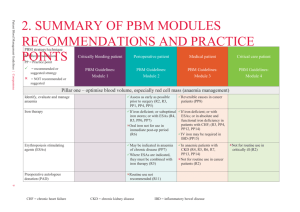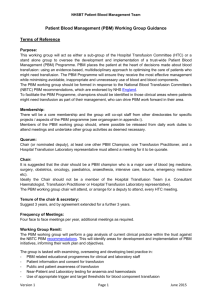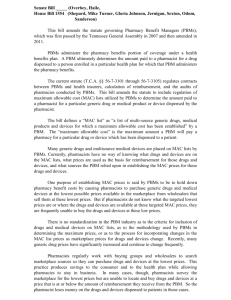docx - National Blood Authority
advertisement
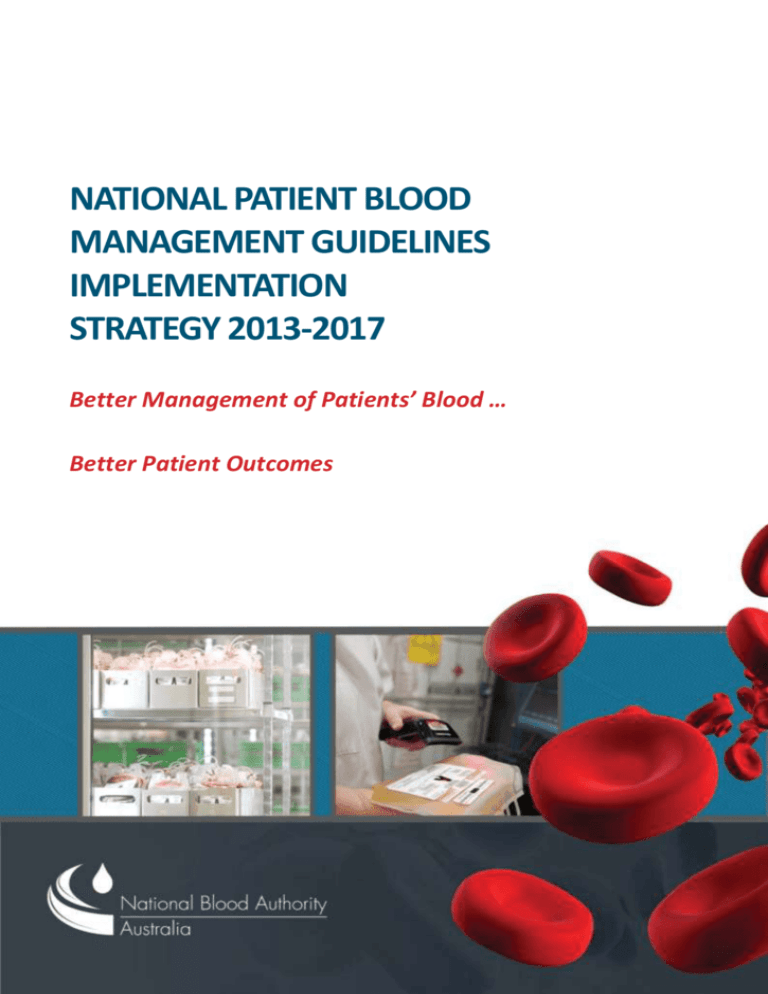
NATIONAL PATIENT BLOOD MANAGEMENT GUIDELINES IMPLEMENTATION STRATEGY 2013-2017 Better Management of Patients’ Blood … Better Patient Outcomes 0 1 Introduction Blood and blood products are used in hospitals across Australia every day to save lives. This unique gift of life is facilitated by the generosity of voluntary blood donors and funded by Australian governments who invest over $1.1 billion per annum in processing, procuring and distributing these products through the Australian Red Cross Blood Service (Blood Service) and other suppliers to health providers. Although blood and blood products remain a critical element of clinical practice, there is increasing evidence that there are risks to patients from allogeneic blood transfusions and that a significant proportion of transfusions are unnecessary or could have been avoided. Allogeneic transfusions can be associated with adverse patient outcomes potentially leading to increased morbidity resulting in delayed recovery or extended hospital stays and increased levels of mortality. Introduction of patient blood management (PBM) can minimise these risks. PBM is a term that has emerged in recent years to describe a range of medical and surgical strategies that aim conserve and optimise the patient’s own blood which in turn helps to avoid or reduce the need for allogeneic transfusion. It is a patient-centred approach that aims to improve clinical outcomes by avoiding unnecessary exposure to blood components. It includes the three pillars of: optimisation of blood volume and red cell mass minimisation of blood loss optimisation of the patient’s tolerance of anaemia. Adoption of a multidisciplinary, coordinated approach to PBM has been reported to result in reductions in red blood cell utilisation (and associated costs), avoidance of transfusion related incidents and adverse events (and associated costs) while achieving equivalent or better patient outcomes 1,2 and a substantial return on investment 3. While the implementation of PBM has resulted in a reduction in red cell utilisation per 1000 population in Australia4 recent unpublished audits indicate that there is still room for improvement. It has been conservatively estimated that a further 5% reduction in red cell use could be achieved. This represents a national saving of $14.6M based on 2011-12 issuage of just over 800,000 units of red blood cells. The imperative for governments to take advantage of opportunities to reduce unnecessary consumption is important, particularly in the context of demographic impacts and technical influences that drive health care activity such as population growth, an aging population and new treatment modalities (e.g. surgical and cancer therapies). Further, many transfusions characterised as ‘appropriate’ on the basis of a pre-transfusion haemoglobin, could be rendered unnecessary if patient’s iron deficiency is treated and patients are allowed adequate time to generate their own red cells and haemoglobin in preference to transplanting another person’s red blood cells. There is a significant challenge to ensure iron deficiency and anaemia is diagnosed and treated in a timely manner. This would represent further reductions in red blood cell utilisation and additional savings to the health sector. Iron deficiency and anaemia is prevalent in Australia, particularly in high risk groups with the following rates being reported 5 iron deficiency anaemia - toddlers 1-6% and up to 14% in Asian group anaemia (all causes) - non-pregnant young women 10% anaemia (all causes) - pregnant women not taking iron supplements 11% anaemia (all causes) - indigenous women 55% and indigenous men 18%. 2 High variation in red cell transfusion prescribing practice has also been reported with transfusions per 1000 surgical separations in Australian states and territories ranging between 76 to 152 per 1000 surgical separations6. Adoption of PBM presents the opportunity to reduce the prevalence of iron deficiency and anaemia, reduce the need for transfusion, standardise transfusion practice and improve patient outcomes while achieving substantial budgetary savings. To support the adoption of PBM across Australia, governments sponsored the National Blood Authority (NBA) to coordinate input from clinical experts across the blood sector to develop a set of contemporary evidence based PBM Guidelines, approved by the National Health and Medical Research Council (NHMRC). The PBM Guidelines consist of six modules that provide recommendations in relation to best PBM clinical practice. The challenge now is to support implementation of these Guidelines which requires a coordinated approach to patient care provided in the primary care and hospital settings by people from a wide range of disciplines. The operational and cultural change required to implement best practice clinical measures at a health provider level are significant and sometimes require complex changes in business process and clinical practice. There are also a range of wider environmental challenges confronting jurisdictions and health providers seeking to implement the change. This paper outlines a strategy to support Jurisdictions and health providers to implement the PBM Guidelines. The strategy is collaborative in nature, drawing on expertise from across the sector to provide the tools and necessary national coordination to support jurisdictions and health providers to implement PBM. The identified program of activities is initially resourced by the NBA, but is iterative in nature. As it develops, it may generate specific projects, resourced by all Australian governments after Jurisdictional Blood Committee approval. Regular updates on progress against items identified in this Strategy will be available online at www.blood.gov.au/patient-blood-management. 3 Patient Blood Management Guidelines In 2006, the NBA established a Clinical Advisory Council comprised of eminent Australian clinicians and academics. This group advised the NBA that the product-focussed NHMRC/ASBT Guidelines on the Use of Blood and Blood Products (2001) needed to be replaced by ‘patient focused’ guidelines and that the emergence of the concept of PBM provided an excellent clinical framework for the new guidelines. They proposed a series of guidelines focussing on specific patient populations. The NBA established a governance framework for the development of these guidelines and sought the advice of a wide range of experts as to the specific populations in which PBM guidelines were required. The PBM Guidelines have been divided into six modules for the following patient populations: Module 1 - Critical Bleeding/Massive Transfusion Module 2 - Perioperative Module 3 - Medical Module 4 - Critical Care Module 5 - Obstetrics Module 6 - Paediatrics/Neonates All Australian Governments have funded the development of the PBM Guidelines under the governance of the Jurisdictional Blood Committee and the NBA. The NBA is project managing and coordinating the development of the Guidelines. A systematic reviewer has been engaged to undertake the systematic reviews and facilitate drafting of each module. The NBA manages all communications and contracts. The NHMRC Council considers each module for approval. The first four modules were considered against the 2007 standards and procedures for externally developed guidelines7, whereas Modules 5 and 6 will be considered against the Procedures and requirements for meeting the 2011 NHMRC Standard for clinical practice guidelines8. Each module is reviewed by methodological and peer reviewers from the international community. In addition, each module is reviewed by an expert assessor using the international quality tool for clinical practice guidelines: Appraisal of Guidelines for Research & Evaluation (AGREE II) Instrument. Hard copies and electronic copies of each module are being made available free of charge from the NBA website. A pocket sized ‘Quick Reference Guide’ is also being published in these two formats. Electronic copies meet the Web Content Accessibility Guidelines (WCAG) AA level of conformance. 4 Ensuring successful implementation Previous studies 9,10,11,12,13,14,15,16 examining the effectiveness of strategies to change clinical practice have demonstrated that efforts are more likely to be effective if they use a multifaceted approach that includes a range of the following features: evidence based content adaptation for local use effective data collection systems to assess and feedback statistics by specialty and clinician clinician involvement in Clinical Pathway development use of an implementation team (e.g. local clinical change team at the local level). In PBM identifying and engaging multiple disciplines (e.g. anaesthetists taking a major role in perioperative care) has been reported to demonstrate particular success evidence-practice gap identification prior to implementation identification of potential barriers to change incorporation of reminder systems use of ongoing education and communication use of effective clinical leadership, including local opinions leaders, as part of a structured program. Of specific importance to the implementation of PBM is the development of policies and procedures for the multimodal approach including a perioperative anaemia/iron-deficiency identification, evaluation and management program. The strategy to implement the PBM Guidelines described below incorporates the above features. 5 The Strategy The national strategy for implementation of the PBM Guidelines is multi-faceted and collaborative in nature. The core element of the strategy is to facilitate activities and development of materials at a national level that support implementation at a health provider level under respective jurisdictional arrangements. The approach will be to draw on existing best practice to develop a range of reference tools and collaboration mechanisms to enable health providers to examine their own practice and choose from the suite of tools for local customisation, branding and adoption where appropriate. This will be supplemented by some national activities where appropriate and effective. Recognising the existing strong relationships between public health providers and the State and Territory governments, State and Territory governments will take the lead in coordination and communication with public health providers with the NBA acting in a supporting capacity. The NBA will assume a greater role with public health providers in specific instances where requested by the relevant state or territory government. Governments recognise the different relationships and largely national approach of the majority of private health providers including primary health care providers. The NBA will take a greater lead role in coordination and communication with private health providers at a national and local level. With the publication and implementation of the new National Safety and Quality Health Service Standards for hospital accreditation and one devoted entirely to Blood and Blood Products, the demand for supportive tools, education, training, data and information resources has risen. The PBM Implementation Strategy will endeavour to develop and implement high quality, well-tailored tools, education, training and health promotion materials to support the implementation of evidence-based practice and attainment of health service accreditation under the new National Safety and Quality Health Service Standards17. The support activity program and development and adoption of national reference tools will be guided by the PBM Steering Committee, consisting of Jurisdictional and relevant experts drawn from across the sector. Activities under the national strategy for implementation of the PBM Guidelines are grouped into four main elements: 1. PBM Tools. The identification, development and promotion of a national reference set of best practice tools to support PBM Guideline implementation, including the development of effective feedback mechanisms and improvement loops; 2. Education and Training. Establishment of a supporting education and training framework; 3. Promotion/Communication. Targeted promotional campaigns and materials to raise awareness and motivate health provider, clinician and patient interest. The campaigns will generate an increased appetite for change. Networks will be encouraged through online opportunities and conferences. 4. Data. The NBA will incorporate the development of key data sets to support the implementation of PBM as a part of its Information and Communications and Technology strategy. 6 Key Implementation Activities EXISTING ACTIVITIES There are a number of activities, completed or underway at the national level that directly or indirectly, supports implementation of the PBM Guidelines. Activities under this strategy are intended to build-on or augment these existing initiatives. Existing activities include: development of education programs including the BloodSafe eLearning Australia program18 and the Post-Graduate Certificate in Transfusion Practice (administered by The University of Melbourne on behalf of the Blood Matters Program)19. research to understand how to influence prescribing of red cells20 development of a National Safety and Quality Standard for Blood and Blood Products17 national stewardship statement for the blood sector21 research into the barriers of uptake of PBM practices undertaken by jurisdictions for the NBA. establishment of a national PBM Steering Committee and Anaemia Management Working Group development of evidence-based PBM Guidelines22. New activities can be categorised into four key themes: PBM Tools, Education, Promotion/ Communication and Data. The strategies to implement PBM under each of these broad themes are described below. PBM TOOL SET A range of tools, to support the implementation of PBM and transfusion best practice, currently exists. The NBA plans to create a searchable web-based interface to help health care administrators and professionals to locate available materials. However, the quality and accessibility of PBM tools varies and very few are available for local adaptation, branding and use. In addition, there are some areas of need where tools have not been developed at all. The NBA will coordinate, through the PBM Steering Committee, the identification, development and promotion of a set of best practice tools relevant to PBM that can be modified and branded by health providers to support PBM Guideline implementation in their own institution. The PBM tools will contribute to a national reference set of tools aiming to support transfusion best practice more broadly. The wider toolset will also include best practice tools relating to non-PBM concepts such as inventory management and transfusion best practice. The NBA will use a collaborative approach to the development of the tools, drawing on relevant jurisdictional and stakeholder expertise or associated work already completed. An overview of the process for development and implementation of the reference tool set is broken into five basic steps: 1. Definition and categorisation of areas requiring supporting tools. This will determine the ‘requirements’ for PBM tools to be included in the wider national reference tool set. The proposed PBM Tool Set is at Attachment A. 2. Identification and adaptation of existing materials and associated stakeholder expertise to meet defined PBM requirements. 3. Provide easy access to the national reference set of tools via a searchable online database. This database will also provide access to tools and materials not included in the national reference set of tools (which can be locally adapted and branded). The searchable database will also include NBA publications (e.g. Annual Reports) and examples of tools used in jurisdictions not identified or included in the national reference tool set. 7 4. Identification of gaps and commissioning of relevant stakeholders/jurisdictions to develop tools to address identified gaps. 5. Review and update PBM tools in the national reference tool set. It should be noted that the ‘tool set’ will not be static and will develop and change over time. The tools are designed to support individuals responsible for implementing PBM at a health provider, individual clinician and patient level. A suite of protocols and policies will be developed for local adaptation and branding. Initial priority will be given to: intraoperative cell salvage guidance restrictive transfusion/single unit policy. EDUCATION AND TRAINING Education and traininga to support development of PBM knowledge and competencies is required across the primary and secondary care settings. These include hospital doctors including junior medical officers and registrars, nurses, general practitioners and specialists. The initial strategy will focus on the following: EMBED PBM IN BLOODSAFE E-LEARNING AUSTRALIA The NBA plans to capitalise on the popularity of BloodSafe eLearning Australia which offers high quality interactive education for health care professionals. The courses attract professional development points and support accreditation against the Blood and Blood Product Standard. Additional PBM courses and content will be developed. NBA will explore and promote incorporation of key courses into relevant medical and nursing curricula. INVESTIGATE AND SUPPORT HOSPITAL BASED EDUCATION AND TRAINING Busy educators of doctors and nurses who offer hospital based education and training would appreciate access to freely available presentations, podcasts and other educational materials that assist in explaining the concepts of PBM. It is the intent of the strategy to identify the topics and produce educational materials that would be valued by hospital based educators. Investigations will be undertaken to better appreciate the barriers to education and training about PBM in the hospital sector. EDUCATION FOR GENERAL PRACTITIONERS General practitioners play a key role in managing anaemia and iron deficiency. The NBA will explore educational partnerships to develop materials such as educational audits to enhance competencies in general practitioners in the identification, diagnosis and management of iron deficiency and iron deficiency anaemia. The NBA will also explore inclusion of eLearning within GP trainee education. INVESTIGATE THE BEST METHODS TO SUPPORT PBM EDUCATION AND TRAINING FOR SPECIALISTS NBA will explore opportunities to collaborate with educational institutions or colleges to support training of specialists and advanced trainees in PBM techniques relevant to their discipline. a Education’ is defined as an educational offering that provides an academic transcript from a recognised Australian university OR is recognised by the clinical college or society by awarding clinical or professional development points. Training is defined as learning opportunities offered in the workplace (typically a hospital), that provide technical information relevant to that workplace. 8 PROMOTION/COMMUNICATION CAMPAIGNS TO PROMOTE PBM The NBA will design and undertake promotional/communication campaigns, targeting specific groups of health providers to enhance awareness of and support for the implementation of PBM. Appropriate key messages and channels of communication will be used to promote education and tools as they become available. These campaigns will be undertaken in conjunction with clinicians, jurisdictions patient advocacy groups and other stakeholders where relevant, noting that the States and Territories will normally lead communication campaigns that target public health providers in their jurisdiction. Campaigns will support key PBM approaches such as: ensuring patients are ‘fit for surgery’ supporting a restrictive transfusion strategy and single unit at a time policy improving awareness of the cost of blood. SUPPORTING PBM NETWORK COMMUNICATIONS The NBA will further develop collaborative PBM networks initiated through the development of the PBM Guidelines to support the widespread adoption and successful implementation of PBM. The NBA will offer a platform for online discussions and information sharing about PBM through a PBM portal available on BloodChat which is an NBA hosted online discussion forum. NBA will continue to provide key information through system user groups (such as the BloodNet User Reference Group) to further discuss and advance the implementation of PBM. These electronic forums will enable PBM champions and enthusiasts to share information about successes and pitfalls in PBM implementation. CONFERENCES The NBA will continue to participate in conferences held by others by: providing information to PBM Champions such as the clinical members of the PBM Guidelines Clinical/Consumer Reference Groups, to enable informed abstracts and presentations. submitting abstracts and presenting at key conferences. exploring the utility of funding and manning conference booths to highlight PBM practices in nonblood related conferences such as surgical and anaesthetic conferences. participating in shaping PBM conferences. The NBA will consider conducting an Australasian symposium to promote better practice in both inventory management and appropriate use. 9 DATA DATA TO SUPPORT PBM PRACTICE IMPROVEMENT The NBA will incorporate the development of key data sets and governance arrangements relevant to PBM as a part of its Information and Communications and Technology Strategy with an initial focus on: determining transfusion and PBM data set(s) required developing peer review reports determining data access rules specific to report audiences developing electronic audit tools (see above). 10 Implementation Activity 2013 2014 2015 2016 2017 PBM Tools Determine requirements for a National PBM Reference Tool Set Adapt available existing tools for the PBM Reference Tool Set Develop a searchable online database to access information Commission development of tools to address gaps Publish tools to address gaps Review and update National PBM Reference Tool Set Education and Training Extend eLearning PBM courses Investigate and support hospital based education and training Education for General Practitioners PBM training for Specialist Practitioners Promotion/Communication Targeted PBM Campaigns: - restrictive transfusion/single unit policy - fit for surgery - the cost of blood Supporting PBM Network Conferences Data to support PBM quality improvement Determine transfusion/PBM data sets required Develop peer review reports Determine data access rules specific to report audiences Develop electronic audit tools (see above) 11 1. Brevig J, McDonald J, Zelinka ES, Gallagher T, Jin R, Grunkemeier GL. Blood transfusion reduction in cardiac surgery: multidisciplinary approach at a community hospital. The Annals of thoracic surgery [Internet]. 2009 Feb;87(2):532–9. Available from: http://www.ncbi.nlm.nih.gov/pubmed/19161774 2. Freedman J, Luke K, Escobar M, Vernich L, Chiavetta JA. Experience of a network of transfusion coordinators for blood conservation (Ontario Transfusion Coordinators [ONTraC]). Transfusion [Internet]. 2008 Feb;48(2):237–50. Available from: http://www.ncbi.nlm.nih.gov/pubmed/18005329 3. DeAnda A, Baker KM, Roseff SD, Green JA, McCarthy H, Aron T, et al. Developing a blood conservation program in cardiac surgery. American journal of medical quality : the official journal of the American College of Medical Quality [Internet]. 21(4):230–7. Available from: http://www.ncbi.nlm.nih.gov/pubmed/16849779 4. National Blood Authority. National Blood Authority Annual Report 2011-2012. Canberra, Australia; 2012. 5. Pasricha S-RS, Flecknoe-Brown SC, Allen KJ, Gibson PR, McMahon LP, Olynyk JK, et al. Diagnosis and management of iron deficiency anaemia: a clinical update. The Medical journal of Australia [Internet]. 2010 Nov;193(9):525–32. Available from: http://www.ncbi.nlm.nih.gov/pubmed/21034387 6. Australian Institute of Health and Welfare. Australian Hospital Statistics 2008-09. Health Service Series Number 34. 2010;34(34). 7. National Health and Medical Research Council (NHMRC). NHMRC standards and procedures for externally developed guidelines. NHMRC. 2007; 8. National Health and Medical Research Council (NHMRC). Procedures and requirements for meeting the 2011 NHMRC Standard for clinical practice guidelines. NHMRC. 2011; 9. Cluzeau FA, Littlejohns P, Grimshaw JM, Feder G, Moran SE. Development and application of a generic methodology to assess the quality of clinical guidelines. International journal for quality in health care : journal of the International Society for Quality in Health Care / ISQua [Internet]. 1999 Feb;11(1):21–8. Available from: http://www.ncbi.nlm.nih.gov/pubmed/10411286 10. Doherty S. Evidence-based implementation of evidence-based guidelines. International journal of health care quality assurance incorporating Leadership in health services [Internet]. 2006 Jan;19(1):32–41. Available from: http://www.ncbi.nlm.nih.gov/pubmed/16548397 11. Grimshaw JM, Thomson MA. What have new efforts to change professional practice achieved? Cochrane Effective Practice and Organization of Care Group. Journal of the Royal Society of Medicine [Internet]. 1998 Jan;91 Suppl 3:20–5. Available from: http://www.pubmedcentral.nih.gov/articlerender.fcgi?artid=1296360&tool=pmcentrez&render type=abstract 12. Grimshaw JM, Shirran L, Thomas R, Mowatt G, Fraser C, Bero L, et al. Changing provider behavior: an overview of systematic reviews of interventions. Medical care [Internet]. 2001 Aug;39(8 Suppl 2):II2–45. Available from: http://www.ncbi.nlm.nih.gov/pubmed/11583120 13. Kinsman L, James E, Ham J. An interdisciplinary, evidence-based process of clinical pathway implementation increases pathway usage. Lippincott’s case management : managing the process of patient care [Internet]. 9(4):184–96. Available from: http://www.ncbi.nlm.nih.gov/pubmed/15273604 14. Stone EG, Morton SC, Hulscher ME, Maglione MA, Roth EA, Grimshaw JM, et al. Interventions that increase use of adult immunization and cancer screening services: a meta-analysis. Annals of internal medicine [Internet]. 2002 May;136(9):641–51. Available from: http://www.ncbi.nlm.nih.gov/pubmed/11992299 15. Choong PF, Langford AK, Dowsey MM, Santamaria NM. Clinical pathway for fractured neck of femur: a prospective, controlled study. The Medical journal of Australia [Internet]. 2000 May;172(9):423–6. Available from: http://www.ncbi.nlm.nih.gov/pubmed/10870534 16. Jamtvedt G, Young JM, Kristoffersen DT, O’Brien MA, Oxman AD. Audit and feedback: effects on professional practice and health care outcomes. The Cochrane database of systematic reviews [Internet]. 2006 Jan;(2):CD000259. Available from: http://www.ncbi.nlm.nih.gov/pubmed/16625533 17. Australian Commission on Safety and Quality in Health Care. Australian Commission on Safety and Quality in Health Care [Internet]. [cited 2013 Jan 18]. Available from: http://www.safetyandquality.gov.au/ 18. BloodSafe. BloodSafe E-learning [Internet]. [cited 2013 Jan 18]. Available from: https://www.bloodsafelearning.org.au/ 19. Victoria Health. Victoria Health [Internet]. [cited 2013 Jan 18]. Available from: http://www.health.vic.gov.au/best/tools/cert.htm 20. Clinical Excellence Commission. Understanding and Influencing Blood Prescription. Australia; 2007. 21. National Blood Authority. National Blood Authority Stewardship Statement [Internet]. Available from: http://www.blood.gov.au/policy/stewardship-statement.html 22. National Blood Authority. National Blood Authority Guidelines Review [Internet]. Available from: http://www.blood.gov.au/guidelines/review.html

